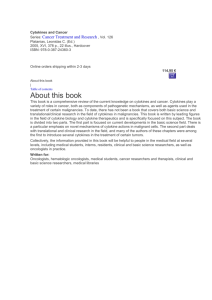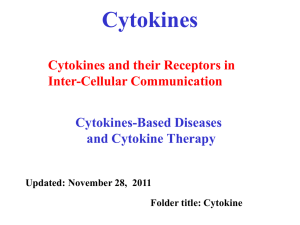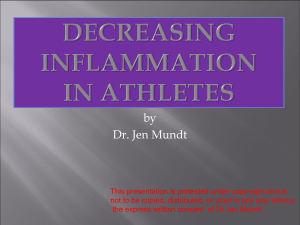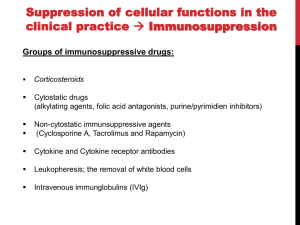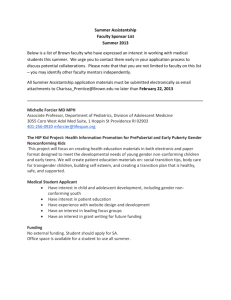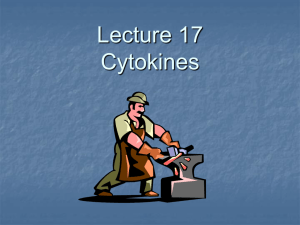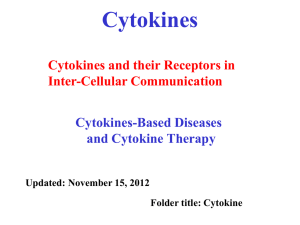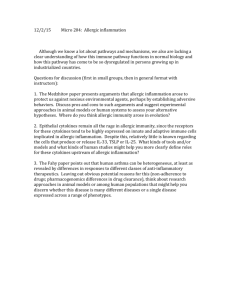Activity 2 SV in Format
advertisement
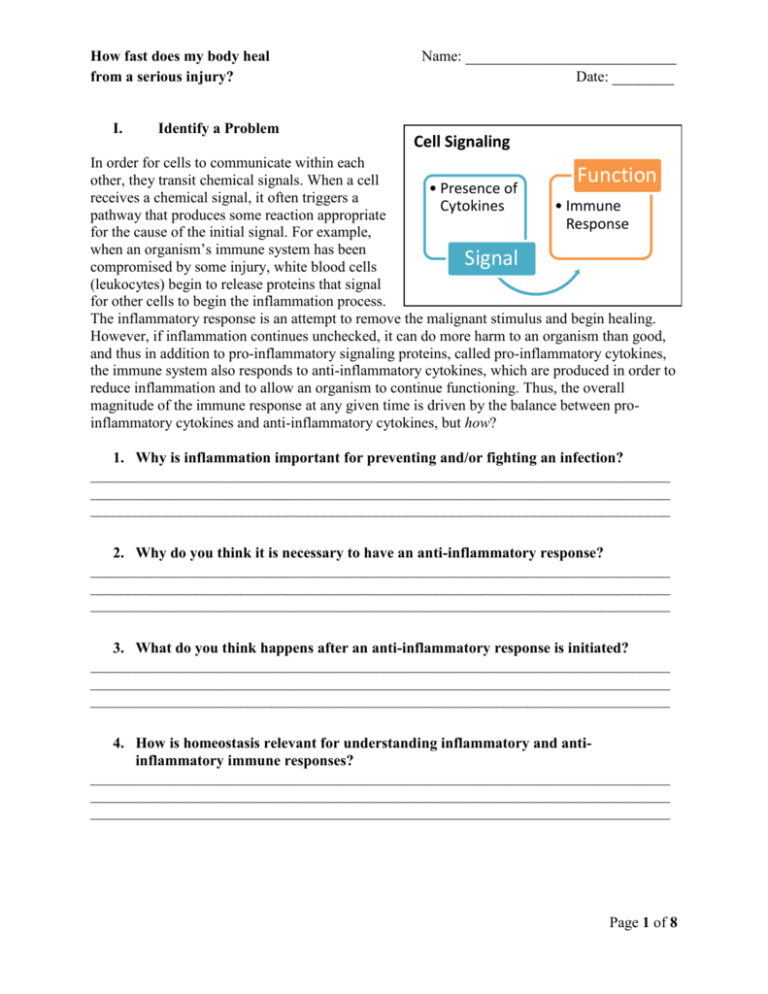
How fast does my body heal from a serious injury? I. Identify a Problem Name: ________________________ Date: _______ Cell Signaling In order for cells to communicate within each Function other, they transit chemical signals. When a cell • Presence of receives a chemical signal, it often triggers a • Immune Cytokines pathway that produces some reaction appropriate Response for the cause of the initial signal. For example, when an organism’s immune system has been Signal compromised by some injury, white blood cells (leukocytes) begin to release proteins that signal for other cells to begin the inflammation process. The inflammatory response is an attempt to remove the malignant stimulus and begin healing. However, if inflammation continues unchecked, it can do more harm to an organism than good, and thus in addition to pro-inflammatory signaling proteins, called pro-inflammatory cytokines, the immune system also responds to anti-inflammatory cytokines, which are produced in order to reduce inflammation and to allow an organism to continue functioning. Thus, the overall magnitude of the immune response at any given time is driven by the balance between proinflammatory cytokines and anti-inflammatory cytokines, but how? 1. Why is inflammation important for preventing and/or fighting an infection? _____________________________________________________________________________ _____________________________________________________________________________ _____________________________________________________________________________ 2. Why do you think it is necessary to have an anti-inflammatory response? _____________________________________________________________________________ _____________________________________________________________________________ _____________________________________________________________________________ 3. What do you think happens after an anti-inflammatory response is initiated? _____________________________________________________________________________ _____________________________________________________________________________ _____________________________________________________________________________ 4. How is homeostasis relevant for understanding inflammatory and antiinflammatory immune responses? _____________________________________________________________________________ _____________________________________________________________________________ _____________________________________________________________________________ Page 1 of 8 How fast does my body heal from a serious injury? II. Name: ________________________ Date: _______ Design an Experiment You have decided you want to see how the presence of different cytokines changes over time after an organism’s immune system has been compromised. You know that because an organism requires homeostasis for survival, eventually a pro-inflammatory response ought to succumb to an antiinflammatory response, but you must design an experiment to determine precisely when or how this happens. You decide to infect mice with Pseudomonas aeruginosa, a common bacterium found in soil, and you decide that you want to measure the concentrations of different cytokines present in blood serum across various time points. To save time and resources, you decide to limit yourself to analyzing the concentration of Interleukin 2 (IL-2), which is a pro-inflammatory cytokine that encourages the creation of T-Cells, and Interleukin 10 (IL-10), which is an anti-inflammatory cytokine that stops the output of IL-2. 5. Why do you think you would only want to analyze the blood serum, as opposed to the blood plasma, or the entire blood sample? (The plasma is what is left when all cells are removed from the blood, and the serum is what is left when all cells AND all clotting factors are removed from the blood.) __________________________________________________________________ __________________________________________________________________ __________________________________________________________________ 6. What units would you expect to use when measuring these concentrations? Why? __________________________________________________________________ __________________________________________________________________ __________________________________________________________________ 7. What sort of trends in your data would you expect to see? __________________________________________________________________ __________________________________________________________________ __________________________________________________________________ 8. Draw how you would imagine a graph displaying this data would look. Page 2 of 8 How fast does my body heal from a serious injury? Name: ________________________ Date: _______ Collecting Data with an ELISA To measure these protein concentrations, you decide to use an enzyme-linked immunosorbent assay (ELISA), which is a fairly common assay in biochemistry laboratories. This technique can detect the presence of a protein or compound in a liquid sample through the use of colorchanging proteins. First, samples containing the protein whose concentrations you want to quantify are loaded into wells on a 96-well plate using a micropipette. Then, antibodies that are design to attach to these specific proteins are also loaded into the wells with samples. These antibodies have attached to them certain enzymes. Lastly, you load into the wells the protein that will change colors if it comes into contact with an enzyme that has been properly connected by means of an antibody to your protein sample. The samples with the highest concentrations of your original proteins will produce a more visible color change. After completing the assay, your results are displayed on the right. Row A contains your control samples; each well in Row A has a specific concentration of antibodies that you already know. For the samples in Row B, you tested for the presence of IL-2, your pro-inflammatory cytokine, and in Row C, you tested for the presence of IL-3, yor anti-inflammatory cytokine. You can determine the concentrations of cytokines in Row B and Row C by comparing their color change to the shades expressed by your controls in Row A. 9. Why is it important to establish a set of controls (or standards of comparison) for your assay? __________________________________________________________________ __________________________________________________________________ __________________________________________________________________ 10. Draw what you would expect the arrangement of molecules to look like based on the description of the assay above. Be sure to label your cytokines, your antibodies, your enzymes, and your color-changing protein. (Hint: The molecules are arranged like links in a chain.) Page 3 of 8 Name: ________________________ Date: _______ How fast does my body heal from a serious injury? III. Analyze an Experiment You collected blood from a patient who has experienced an insult to their immune system, and you measured the concentrations of two cytokines in the serum across the following time points. You decided to measure interleukin-2, which is a proinflammatory cytokine, and interleukin-10, which is an antiinflammatory cytokine. 1hr Concentration 37 of IL-2 (pg/μL) Concentration 19 of IL-10 (pg/μL) 3 hr 6 hr 12 hr 63 94 113 24 hr 125 36 hr 97 48 hr 61 60 hr 33 72 hr 18 84 hr 15 96 hr 21 17 39 60 79 100 121 123 98 16 25 11. Use a scatterplot to display the above data. Remember to include useful labels and an accurate scale! 12. Why might you not have a time point at immediately after the insult (i.e. at 0 hrs)? __________________________________________________________________ __________________________________________________________________ 13. What quantitative trends do you initially notice based on your graph? __________________________________________________________________ __________________________________________________________________ __________________________________________________________________ Page 4 of 8 How fast does my body heal from a serious injury? Name: ________________________ Date: _______ 14. If you were to fit this data to a mathematical function, what type of function would be the best fit? If one regression may fit part of a graph better than another, give the relevant domain (x values), and explain why. a. Polynomial ______________________________________________ b. c. d. e. ________________________________________________________ Linear ______________________________________________ ________________________________________________________ Sinusoidal ______________________________________________ ________________________________________________________ Exponential ______________________________________________ ________________________________________________________ Logarithmic ______________________________________________ ________________________________________________________ 15. If you were a doctor, and you wanted to prescribe your patient a drug which would reduce the expression of inflammatory cytokines, why might it be important to consider the type of function, or the rate, at which the cytokines are increasing? (Remember that drugs are chemicals, and every chemical reaction has its own reaction rate as well.) __________________________________________________________________ __________________________________________________________________ __________________________________________________________________ 16. Given the total amount of cytokines present in the samples at each given time point, determine what concentrations you would expect to have if the proportion between pro-inflammatory cytokines and anti-inflammatory cytokines remained 1:1. (Hint: If the concentrations are proportional in a 1:1 ratio, half of the cytokines will be pro-inflammatory, and half of the cytokines will be anti-inflammatory.) 1hr 3 hr 6 hr 12 hr 24 hr 36 hr 48 hr 60 hr 72 hr 84 hr 96 hr Total concentration 56 of cytokines Expected concentration 28 of IL-2 at a 1:1 ratio Expected concentration 28 of IL-10 at a 1:1 ratio Page 5 of 8 Name: ________________________ Date: _______ How fast does my body heal from a serious injury? 17. Use a chi-square goodness-of-fit test for each of the following time points with the pro-inflammatory cytokines and anti-inflammatory cytokines. Use your experimental data for your observed values, and compare these to the expected concentrations you calculated above. (Hint: For all time-points, your degree of freedom is 1.) Null Hypothesis: H0 : Cytokine concentrations are equal Alternative Hypothesis: H1 : Pro-Inflammatory > Anti-Inflammatory 1 hour: 𝑿𝟐 = ∑ (𝒐𝒃𝒔𝒆𝒓𝒗𝒆𝒅−𝒆𝒙𝒑𝒆𝒄𝒕𝒆𝒅)𝟐 𝒆𝒙𝒑𝒆𝒄𝒕𝒆𝒅 P-Value: 2 hours: 𝑿𝟐 = ∑ 0.05 p < (𝒐𝒃𝒔𝒆𝒓𝒗𝒆𝒅−𝒆𝒙𝒑𝒆𝒄𝒕𝒆𝒅)𝟐 P-Value: 𝒆𝒙𝒑𝒆𝒄𝒕𝒆𝒅 = (𝟑𝟕−𝟐𝟖)𝟐 𝟐𝟖 0.10 + (𝟏𝟗−𝟐𝟖)𝟐 𝟐𝟖 = 𝟓. 𝟕𝟗 P-Value Comparison: p < a = _______ < p < _______ P-Value Comparison: p ____a 3 hours: 36 hours: Null Hypothesis: Alternative Hypothesis: 48 hours: H0 : Cytokine concentrations are equal H1 : Anti-Inflammatory > Pro-Inflammatory 60 hours: 96 hours: 18. At what time points can you say that there is not a statistically significant difference between the concentrations of the two cytokines? What does this imply about the immune response for these time points? __________________________________________________________________ __________________________________________________________________ __________________________________________________________________ Page 6 of 8 How fast does my body heal from a serious injury? Name: ________________________ Date: _______ 19. Why might you decide to use a 1:1 ratio between cytokines for your Chi-Square test? How might this relate to an organism maintaining homeostasis? __________________________________________________________________ __________________________________________________________________ __________________________________________________________________ 20. At what time point would you assert that the condition of the patient made a discernible change? What was that change? __________________________________________________________________ __________________________________________________________________ __________________________________________________________________ 21. Assuming your data is still valid, what sort of additional data would be able to disprove your hypothesis? __________________________________________________________________ __________________________________________________________________ __________________________________________________________________ 22. How might your interpretation of the data change if you decided to measure the concentrations of additional cytokines? __________________________________________________________________ __________________________________________________________________ __________________________________________________________________ 23. Cell signals such as cytokines can produce cascades, meaning that when one cell receives the signal, that cell then sends that signal out to more cells. What do you think happens inside the cell between the time the cell receives a protein signal on its membrane and the time the cell releases its own protein signals? __________________________________________________________________ __________________________________________________________________ __________________________________________________________________ Page 7 of 8 How fast does my body heal from a serious injury? Name: ________________________ Date: _______ 24. You know that a patient will become severely septic if their inflammation becomes too excessive. What would you expect the cytokine concentrations to be in such a patient? Supply hypothetical values, and explain your reasoning for choosing such values. t = 1hr t = 6hrs t = 12hrs t = 24hrs t = 36hrs t = 48hrs t = 72 hrs Concentration of IL-2 (mg/μL) Concentration of IL-10 (mg/μL) __________________________________________________________________ __________________________________________________________________ __________________________________________________________________ 25. At what time point in your new data would you, as a doctor, become concerned by the results being returned from this lab? __________________________________________________________________ __________________________________________________________________ __________________________________________________________________ 26. Biologically speaking, what do you think you would need to do as a doctor to prevent this patient from becoming severely septic? __________________________________________________________________ __________________________________________________________________ __________________________________________________________________ Page 8 of 8
